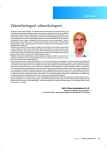Dysgeusia in the elderly
Authors:
MUDr. Hana Suchánková., Ph.D. 1 3; PharmDr. Jitka Rychlíčková, Ph.D. 2; MUDr. Jan Strojil, Ph.D. 3
Authors‘ workplace:
II. interní klinika – gastroenterologická a geriatrická FN Olomouc
1; Farmakologický ústav LF MU
2; Ústav farmakologie, LF UP a FN Olomouc
3
Published in:
Geriatrie a Gerontologie 2020, 9, č. 4: 194-197
Category:
Review Article
Overview
With increasing age, the incidence of sensory disorders rises and given the frequent multimorbidity and deteriorating adaptability in geriatric patients, their consequences may be significant in the elderly. Taste disorders, dysgeusias, frequently develop unnoticed and may contribute to malnutrition, decompensation of other somatic diseases, or negatively affect quality of life. The aim of this paper is to draw attention to the existence of these not very rare disorders and their possible consequences and to discuss current strategies for management of dysgeusia.
Keywords:
dysgeusia – taste disorders – aging – geriatric patient
Sources
1. Spence C. Multisensory flavor perception. Cell 2015; 161(1): 24–35.
2. Syed Q, Hendler KT, Koncilja K. The Impact of Aging and Medical Status on Dysgeusia. Am J Med 2016; 129(7): 753.e1-6.
3. Howell J, Costanzo RM, Reiter ER. Head trauma and olfactory function. World J Otorhinolaryngol - Head Neck Surg 2018; 4(1): 39–45.
4. Spence C. Do men and women really live in different taste worlds? Food Qual Prefer 2019; 73: 38–45.
5. Wang T, Glendinning J, Grushka M. et al. From the Cover: Drug-Induced Taste Disorders in Clinical Practice and Preclinical Safety Evaluation. Toxicol Sci 2017; 156(2): 315–324.
6. Breslin PAS, Spector AC. Mammalian taste perception. Curr Biol CB 2008; 18(4): R148-155.
7. Kershaw JC, Mattes, RD. Nutrition and taste and smell dysfunction. World J Otorhinolaryngol - Head Neck Surg 2018; 4(1): 3–10.
8. Tatzer E, Schubert MT, Timischl W et al. Discrimination of taste and preference for sweet in premature babies. Early Hum Dev 1985; 12(1): 23–30.
9. Mennella JA, Pepino MY, Reed DR. Genetic and Environmental Determinants of Bitter Perception and Sweet Preferences. Pediatrics 2005; 115(2): e216–e222.
10. Noel C, Dando R. The effect of emotional state on taste perception. Appetite 2015; 95: 89–95.
11. Mattes RD. Accumulating evidence supports a taste component for free fatty acids in humans. Physiol Behav 2011; 104(4): 624–631.
12. Takamata A, Mack GW, Gillen CM, et al. Sodium appetite, thirst, and body fluid regulation in humans during rehydration without sodium replacement. Am J Physiol 1994; 266(5 Pt 2): R1493-1502.
13. Cavazzana A, Röhrborn A, Garthus-Niegel S, et al. Sensory-specific impairment among older people. An investigation using both sensory thresholds and subjective measures across the five senses. PLOS ONE 2018; 13(8): e0202969.
14. Fukunaga A, Uematsu H, Sugimoto K. Influences of Aging on Taste Perception and Oral Somatic Sensation. J Gerontol Ser A 2005; 60(1): 109–113.
15. Glazar I, Urek MM, Brumini G, et al. Oral sensorial complaints, salivary flow rate and mucosal lesions in the institutionalized elderly. J Oral Rehabil 2010; 37(2): 93–99.
16. Doty RL. Measurement of chemosensory function. World J Otorhinolaryngol - Head Neck Surg 2018; 4(1): 11–28.
17. Fitzgerald C, Wiese G, Moorthi RN, et al. Characterizing Dysgeusia in Hemodialysis Patients. Chem Senses 2019; 44(3): 165–171.
18. Najafizade N, Hemati S, Gookizade A, et al. Preventive effects of zinc sulfate on taste alterations in patients under irradiation for head and neck cancers: A randomized placebo-controlled trial. J Res Med Sci Off J Isfahan Univ Med Sci 2013; 18(2): 123–126.
19. Kinugasa Y, Nakayama N, Sugihara S, et al. Polypharmacy and taste disorders in heart failure patients. Eur J Prev Cardiol 2020; 27(1): 110–111.
20. Mortazavi H, Shafiei S, Sadr S, et al. Drug-related Dysgeusia: A Systematic Review. Oral Health Prev Dent 2018; 16(6): 499–507.
21. Hamada N, Endo S, Tomita H. Characteristics of 2278 patients visiting the Nihon University Hospital Taste Clinic over a 10-year period with special reference to age and sex distributions. Acta Oto-Laryngol Suppl 2002; (546): 7–15.
22. Rychlíčková J, Suchánková H. Dysgeuzie jako nežádoucí účinek léčiv a její možné klinické důsledky. Remedia 2020; 30(3): 349–352.
23. Chen, JJ, Chang HF, Chen DL. Recurrent episodic vertigo secondary to hyponatremic encephalopathy from water intoxication. Neurosci Riyadh Saudi Arab 2014; 19(4): 328–330.
24. Mattes RD, Cowart BJ. Dietary assessment of patients with chemosensory disorders. J Am Diet Assoc 1994; 94(1): 50–56.
25. Turcott JG, Juárez-Hernández E, Sánchez-Lara K, et al. Baseline Dysgeusia in Chemotherapy-Naïve Non-Small Cell Lung Cancer Patients: Association with Nutrition and Quality of Life. Nutr Cancer 2020; 72(2): 194–201.
26. Schiffman SS. Influence of medications on taste and smell. World J Otorhinolaryngol - Head Neck Surg 2018; 4(1): 84–91.
27. Rademacher, WMH, Aziz Y, Hielema A, et al. Oral adverse effects of drugs: Taste disorders. Oral Dis 2020; 26(1): 213–223.
Labels
Geriatrics General practitioner for adults Orthopaedic prostheticsArticle was published in
Geriatrics and Gerontology

2020 Issue 4
Most read in this issue
- Dysgeusia in the elderly
- Nutritional support. Part of complex care for geriatric patients
- Vascular acess in the elderly
- Psychometric validation of Czech version of the questionnaire Jacelon Attributed Dignity Scale.
